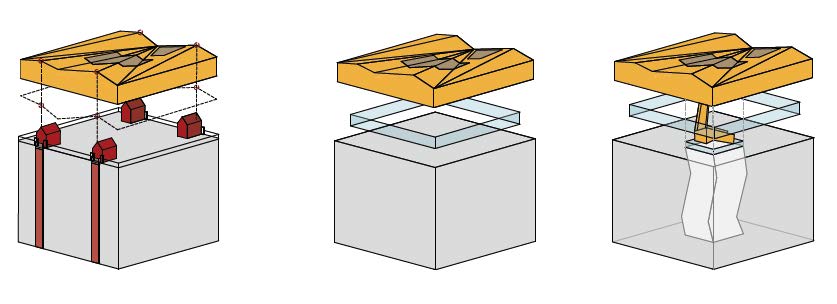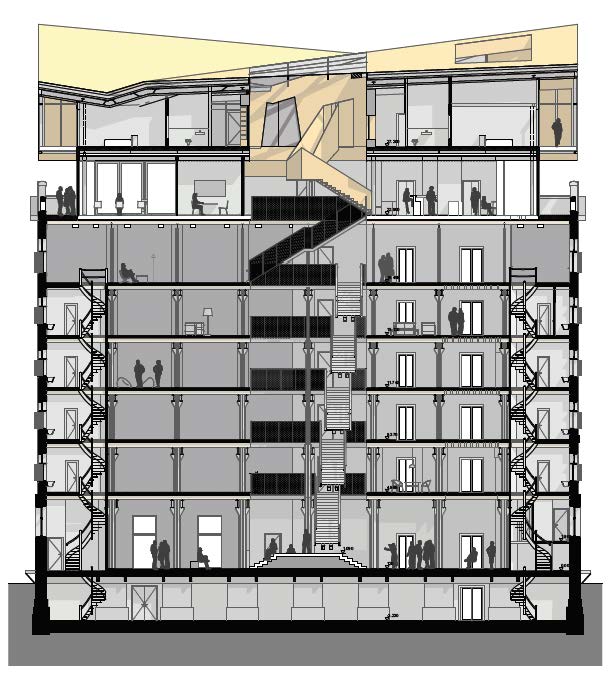From 2012 until 2017 building volumes in the Netherlands collapsed due to the worldwide economic crisis. In this period the demand for housing (based on the ratio households/actual number of housing units) grew steadily [4]. This has led to a housing shortage of statistically 200.000 houses in 2018 [5]. The popularity of cities further increased the housing shortage. In an attempt to decrease this shortages, the national government (together with developers, housing corporations, realtors and other actors in the housing field) have announced in the ‘nationale woonagenda’ 2018-2021 (transl. national housing agenda 2014-2021) that until 2021, each year 75.000 housing units should be built [6]. To achieve this goal, they argue that ‘we have to be creative […] Industrial areas and for instance waterfront areas should be investigated for redevelopment, though we should not be afraid to sacrifice green plots at the edges of towns’ [7]. Such inner city development also means developing within existing urban structures. Heritage is thus an important asset within these developments.
The Waterfront as a hub for inner-city expansion in Rotterdam
One of the areas that experiences this pressure include the old port areas of Rotterdam, home to the largest sea port in Europe. The port covers approximately 12.643 hectares and stretches for over 40 kilometres from the inner-city of Rotterdam to the shores of the North Sea. As the port grew westward, vacant port areas have been restructured since the 1980’s. The housing market in Rotterdam today is exemplary of the Dutch housing situation, but Rotterdam also has its own specific challenges. The city, which has a long industrial and port tradition, has been known for low incomes and high crime rates [8]. In the past years the image of the city has become more positive. The growing popularity of the city means increasing demand for business location, and increasing demand for housing. An extra 50.000 houses are needed until 2040. That is a 16% increase of the current number of houses within 20 years. Most of these houses are planned on inner-city locations such as old ports. Due to ongoing reduction of port functions, Rotterdam has a large number of inner-city plots to redevelop compared to other cities in the Netherlands.
Development of the Rotterdam port. (Source: https://futureland.nl/activiteit/haventijdreis-rotterdam-vv-futureland)
While the industry is retracting, not all heavy industry has left the city. The construction of new housing occasionally clashes with the remaining heavy industry. Financial feasibility is also an important theme for Dutch inner-city planning. Even though housing prices are higher than ever, costs for developing these sites (including heritage) heavily influence decision-making. This is why it is important to understand the positive financial impact of heritage in urban redevelopment.
Rijnhaven
The Rijnhaven is one of the last remaining inner-city port locations to be redeveloped within Rotterdam. The former port is located on the south bank of the river Maas – traditionally the poor side of the city close to the center. The Rijnhaven was constructed from 1887 until 1895. It was first used to keep ships that couldn’t sail the river Rhine during the winter. Later on, between 1887 and 1897, the harbour was used as a sea port for large scale transhipment. After a few years it again became a harbour for inland shipping. Just one operating factory is left in the Rijnhaven. In the past years, the surrounding neighbourhoods have been redeveloped or are under construction. Between the Wilhelminapier, known as Manhattan aan de Maas, (because of the new and dense high rise), and Katendrecht (a former harbour long known for its red light district that is now mostly gentrified), the Rijnhaven has the highest m2 price for housing in Rotterdam. The bar is thus set high for this former sea port. First development plans for the area propose a large park and high-end mixed-use area.
Rijnhaven 1928. (Source: https://www.rotterdam.nl/wonen-leven/rijnhaven/180816-doc-cultuur-historische-verkenning.pdf p. 66)
The former warehouse Santos, named after Brazilian coffee it housed , is one of the few remaining warehouses in the Rijnhaven. It stood in the second line of warehouses, and thus not directly at the edge of the water. The five-story warehouse was built in 1901-1902 by the architects J.P. Stok Wzn and J.J. Kanters as a storage for coffee. It was equipped with an advanced loading system, which only later was adapted in other warehouses. The building has two identical fronts with vertical loading docks. On the harbour side, goods entered the warehouse. On the Brede Hilledijk side goods were transported out of the warehouse. During the bombings of World War II a lot of buildings surrounding the Rijnhaven were destroyed, yet Santos remained.
In the past decades, businesses moved nearer to the North Sea and away from the city, as new and more efficient ports were built and the Rijnhaven lost its seaport function. The Santos warehouse was no longer used. It has had several temporary uses such as storage since 2011, but has been vacant most of the time. In the past years, as interest by both residents and developers in the surrounding neighbourhoods (Wilhelminapier and Katendrecht) has grown, Santos has been the object of various studies. Following the economic crisis, Stilwerk (a German design department store) bought the building in 2017 and will transform the 1.140 m2 warehouse into a design department store.
Historic map of the Rijnhaven and location of Santos. (Source: Gemeentearchief Rotterdam)
Groundplan Santos 1901. (Source: Gemeentearchief Rotterdam)
New use and design
Stillwerk has chosen Rotterdam as new location because of the experimental and design orientated atmosphere. Stilwerk, established since 1996 in a historic warehouse near the Fischmarkt in Hamburg Altona [9] is going to reuse Santos as a design department store. Stillwerk states: “It reminds us of our location in Hamburg. We love old buildings. […] The construction is still intact. We estimate the total investment on 12 – 16 million euro’s [10]. The architect (Wessel de Jonge Architecten) states: “It is a beautiful monumental object that we embrace yet give it a contemporary function and meaning. We like to combine old and new to create a contrast and a dialogue between historic and modern design [11]. The transformation of the building is meant to house mixed-use functions on the ground floor (café, restaurant, retail, events) that help revitalize the surrounding area. The open floor plan will be preserved and can be rented by design companies for display. A co-working area will be made which can also be used as a conference center. On top of this, 22 short stay service apartments will be added in a two stories extension.
To make the monument fit for its new function, the historic exterior and interior are preserved. To add light and air, an atrium is formed in the middle of the building with staircases as an eye catcher. The building is topped with a new element ‘a golden crown’. This new roof top emphasizes the contrast between old and new. It also makes the location more visible and gives a great view from the top of the building.
(a) Historic image of Santos warehouse. (Source: https://www.rotterdam.nl/wonen-leven/rijnhaven/180816-doc-cultuur-historische-verkenning.pdf; p.64) (b) Santos warehouse today. (Source: Renner Hainke Wirth Zirn Architekten & Wessel de Jonge, Stilwerk Santos Rotterdam Concept December 2018) (c) Plan for Santos warehouse. (Source: Renner Hainke Wirth Zirn Architekten & Wessel de Jonge, Stilwerk Santos Rotterdam Concept December 2018; Copyright: Renner Hainke Wirth Zirn Architekten & Wessel de Jonge)
Concept. (Source: Renner Hainke Wirth Zirn Architekten & Wessel de Jonge, Stilwerk Santos Rotterdam Concept December 2018; Copyright: Renner Hainke Wirth Zirn Architekten & Wessel de Jonge)
Section. (Source: Renner Hainke Wirth Zirn Architekten & Wessel de Jonge, Stilwerk Santos Rotterdam Concept December 2018; Copyright: Renner Hainke Wirth Zirn Architekten & Wessel de Jonge)
Economic impact of the Santos warehouse
Choices about inner-city developments in which heritage should be preserved rarely consider the economic impact of preservation. Instead, they are often based on monumental status, aesthetics or possibilities of a particular object for reuse (mainly residential). When looking at Santos we see that these three are combined. Santos is a monument, with aesthetics that are popular nowadays and has possibilities for reuse. As for the economic impact concerned we can discern two kinds. On the one hand, we have the direct business case: whether the reuse of Santos is an interesting business case or not is questionable. Initial costs are high and the plot cannot be used in the most efficient way. The extra two stories for apartments can make the business feasible. But, the use is still sub-optimal compared to a new building and plot use. On the other hand, more broadly, we see taxes (real estate, tourists), investment climate and rising housing prices in the surrounding area. These rely on the presence of Santos and the historical look and feel of the Rijnhaven.
Economic impact of (maritime) Heritage in general
For planners and decision makers it is important to be able to grasp the economic value of heritage. Reasons whether or not to preserve lack an economic and therefore objective point of view. When it comes to the simple question what to preserve and what not to preserve, decisions are often based on “gut feeling”. By all means, monuments are preserved. But what about old warehouses that are not of significant cultural status? Should these be preserved or partly preserved? When does (partial) preservation add to the quality of the site and when does it not? How can this quality be defined? Is it a matter of new function (bar, theatre, library, residential), location, or look and feel of a place? What does environmental quality mean for the economic feasibility of a plan?
The economic impact of heritage within the planning practice has different perspectives. Reuse of heritage impacts the direct business case (costs vs. yields) both on the building and the urban level. In the long run, it also has influence on the business case (taxes for real estate and f.i. tourists). Value capturing is often mentioned in this context [12]. It is also important to look into strategies for development. Examples for this can be found in the reuse of a façade, a new construction upon an old construction, air rights, costs for redevelopments that are shared on site level instead of solely on plot level. Both the quantification of quality as different kinds of development strategies should be combined in a framework for economic decision-making on heritage within redevelopment.
Notes
[1] Rijksdienst cultureel Erfgoed (2016) ‘The Blind spot, metropolitan landscape in the global battle for talent’ Rotterdam, http://deltametropool.nl/nl/blind_spot
[2] Kleijn, de M. (2013) ‘Economische Waardering van Erfgoed’ Vrije Universiteit, Amsterdam.
[3] Linssen, M. (2009) ‘De Kracht van de argumentatie’ Projectbureau Belvedere, Utrecht.
[4] Rabobank (2018) Bouwbericht 2018. ‘Krapte dicteert groei, innovatie biedt sector kansen’ Utrecht.
[5] Cobouw (2018) ‘Woningtekort loopt nog jaren op’ www.cobouw.nl (read february 2019).
[6] Rijksoverheid (2018) ‘Nationale woonagende 2018-2021’.
[7] Nu.nl (2018) ‘Nationale Woonagenda moet jaarlijks tot bouw 75.000 huizen leiden’ www.nu.nl (read may 2018).
[8] https://www.ad.nl/rotterdam/daling-criminaliteit-in-rotterdam~a3968632/
[9] https://stilwerk.com/de/hamburg/
[10] https://www.ad.nl/rotterdam/pakhuis-santos-wordt-design-warenhuis~adb6cce4/
[11] http://www.kunjijdekaapaan.nl/stilwerk-zet-plannen-voor-santos-gebouw-definitief-door/
[12] RVO (2019) ‘TFC-constructie: Value Capturing’ www.rvo.nl (read february 2019).
Head Image: Rijnhaven nowadays. (Source: https://www.rotterdam.nl/wonen-leven/rijnhaven/27837-22-Eindrapportage_Participatie_en_marktconsultatie_Rijnhaven-met_bijlagen_v4.pdf)






